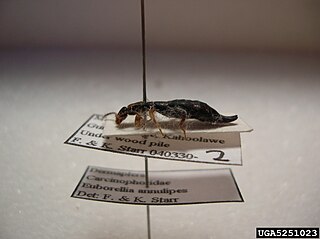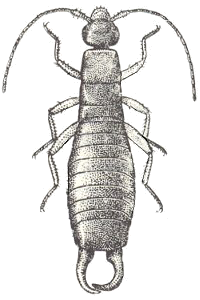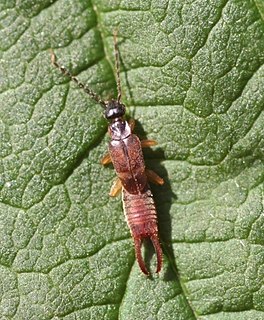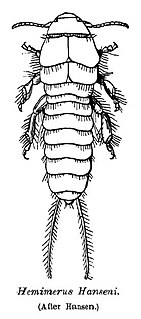
Forficula auricularia, the common earwig or European earwig, is an omnivorous insect in the family Forficulidae. The European earwig survives in a variety of environments and is a common household insect in North America. The name earwig comes from the appearance of the hindwings, which are unique and distinctive among insects, and resemble a human ear when unfolded; the species name of the common earwig, auricularia, is a specific reference to this feature. However, they are considered a pest because of the damage they do to crops, their frightening appearance, their ability to fly, foul odor, and tendency to invade crevices in homes and consume pantry foodstuffs.

David "Honeyboy" Edwards was a Delta blues guitarist and singer from Mississippi.

"The Sea and Little Fishes" is a short story by Terry Pratchett, written in 1998. It is set in his Discworld universe, and features Lancre witches Granny Weatherwax and Nanny Ogg. It was originally published in a sampler alongside a story called "The Wood Boy" by Raymond E. Feist, and later in a collection called Legends.

The Saint Helena earwig or Saint Helena giant earwig was a large species of earwig endemic to the oceanic island of Saint Helena in the south Atlantic Ocean. It is now considered extinct.

Forficulidae is a family of earwigs in the suborder Forficulina.

The Orthopterida is a superorder of the Polyneoptera that represents the extant orders Orthoptera, and Phasmatodea. The Orthopterida also includes the extinct orders Titanoptera and Caloneurodea. There is general consensus of monophyly in this superorder, based on reduction of the second valvulae, an ovipositor derived from the gonoplac, and an enlarged precostal region on the forewing.

Labidura riparia is a species of earwig in the family Labiduridae characterized by their modified cerci as forceps, and light tan color. They are more commonly known as the striped earwig, due to two dark longitudinal stripes down the length of the pronotum. They are sometimes wrongly referred to as Labidura japonica, although said species is actually a subspecies, Labidura riparia japonica, found only in Japan. L. riparia are a cosmopolitan species primarily in tropical to subtropical regions. Body size varies greatly, ranging from 16 mm to 30 mm, with 10 abdominal segments. Males and females differ in forcep size, with males having much larger and stronger curve, while females have smaller, straighter forceps with a slight curve at the end. Earwigs use these forceps to assist in predation, defense, sexual selection, courting and mating, and wing folding.

Forficulina is the largest of the four suborders of earwigs, in the order Dermaptera. The other three are Archidermaptera, which is extinct, Arixeniina, and Hemimerina. They make up the largest and most familiar group. The cerci are unsegmented, and modified into large, forcep-like structures. Females have unhooked cerci, while males have hooked cerci.

Anisolabididae is a family of earwigs, in the suborder Forficulina and the order Dermaptera. It is one of nine families in the suborder Forficulina, and contains thirty-eight genera spread across thirteen subfamilies.

Anisolabidinae, alternatively known as Carcinophorinae, Gonolabiinae, Placolabidinae, or Titanolabiinae, is a subfamily of earwigs that contains approximately twenty-five genera. Its existence was cited by Srivastava in the book Fauna of India Pt. 2, by Chen & Ma in Fauna Sinica, and by Henrik Steinmann in The Animal Kingdom. Although Steinmann cited the subfamily's name as Carcinophorinae, this is a synonym for the taxon.
Chelisochidae is a family of earwigs whose members are commonly known as black earwigs. The family contains a total of approximately 96 species, spread across sixteen genera in three subfamilies.

Labiduridae, whose members are known commonly as striped earwigs, is a relatively large family of earwigs in the suborder Forficulina.

The ringlegged earwig is a species of earwig in the family Anisolabididae.

Anisolabis maritima, commonly known as the maritime earwig or the seaside earwig, is a species of earwig in the family Anisolabididae. Similar to the Seashore earwig, this species can be found near the shore line, and is cosmopolitan. It can be found in almost all ecozones. Scientists believe that these earwigs originally came from Asia. Since then, however, they have been introduced to North America, and have now spread around the world due to international commerce.

Labia minor, the lesser earwig or small earwig, is a species of earwig. It is widespread globally in temperate climates, preferring warm locations such as compost heaps in parts of its range. It is 4–7 mm long, including the pincer, and chocolate brown in color.

Astreptolabis is an extinct genus of earwig in the Dermaptera family Pygidicranidae known from a Cretaceous fossil found in Burma. The genus contains a single described species, Astreptolabis ethirosomatia and is the sole member of the subfamily Astreptolabidinae.
Earwig Music Company is an American blues and jazz independent record label, founded by Michael Frank in October 1978 in Chicago.














